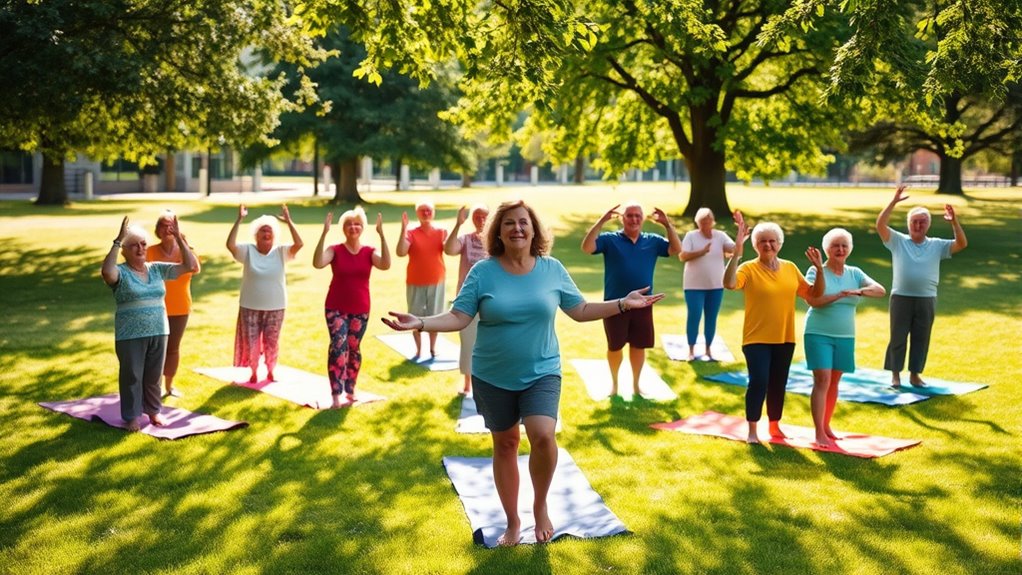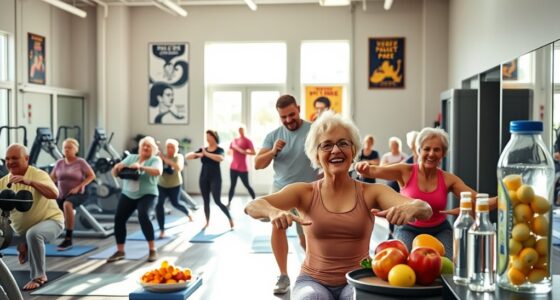The perfect exercise program for seniors combines aerobic activities, strength training, balance, and flexibility routines. Aim for 150 minutes of moderate aerobic exercise weekly, along with muscle-strengthening activities at least twice a week. Incorporate balance exercises three times a week and flexibility routines daily to boost mobility. Low-impact options like walking or swimming are great. Stay motivated by setting goals and engaging in group activities. There’s so much more to explore to enhance your fitness journey.
Key Takeaways
- Incorporate at least 150 minutes of moderate aerobic activities weekly, such as walking or swimming, to enhance cardiovascular health.
- Include muscle-strengthening exercises at least twice a week targeting major muscle groups for improved strength and mobility.
- Practice flexibility and balance exercises daily, like stretching and Tai Chi, to improve range of motion and prevent falls.
- Create a safe and motivating environment by engaging in group classes and setting realistic, achievable fitness goals.
- Stay hydrated and listen to your body, allowing for rest days to promote recovery and prevent overexertion.
Benefits of a Tailored Exercise Program for Seniors
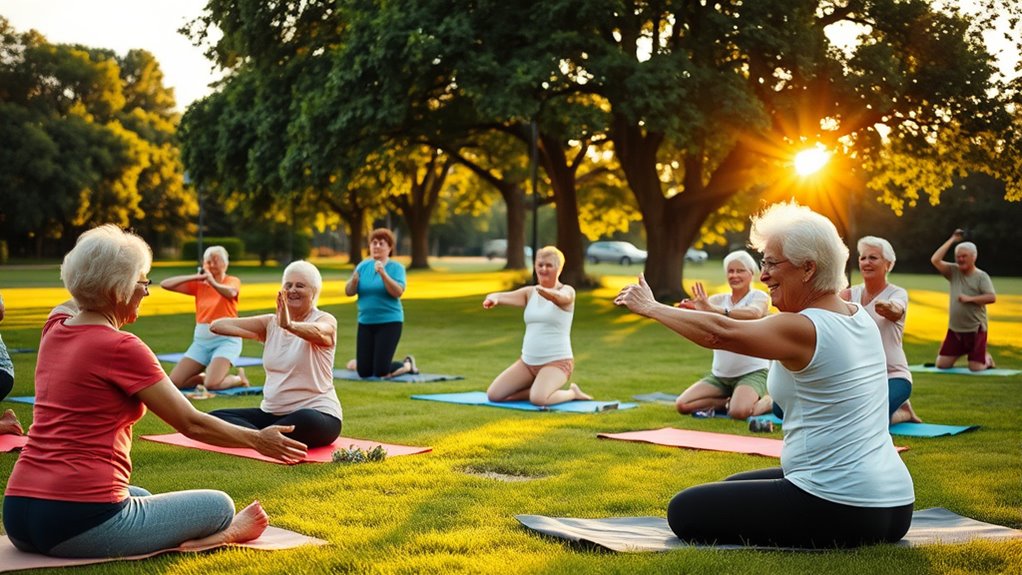
When you engage in a tailored exercise program designed for seniors, you’re not just getting fit; you’re also prioritizing your safety and well-being. These programs offer numerous benefits, specifically catering to your individual fitness level and abilities. By focusing on muscle strength, they help you improve balance, which considerably reduces the risk of falls. Additionally, a tailored exercise program enhances your cardiovascular health, lowering the chances of chronic diseases like heart disease and diabetes. Engaging in regular physical activity can also alleviate feelings of isolation for seniors, making it an essential part of overall health. Furthermore, participating in consistent exercise can lead to improved mental health by promoting the release of endorphins, which are known to elevate mood. Moreover, regular exercise can foster emotional resilience, helping seniors cope with the challenges of aging.
Creating a safe and comfortable home environment is equally important as it supports aging in place and encourages physical activity. You’ll also notice a boost in your mental health, as regular activity reduces anxiety and depression while sharpening cognitive function. Moreover, incorporating regular physical activity can significantly improve overall well-being and longevity.
Key Components of an Effective Exercise Routine
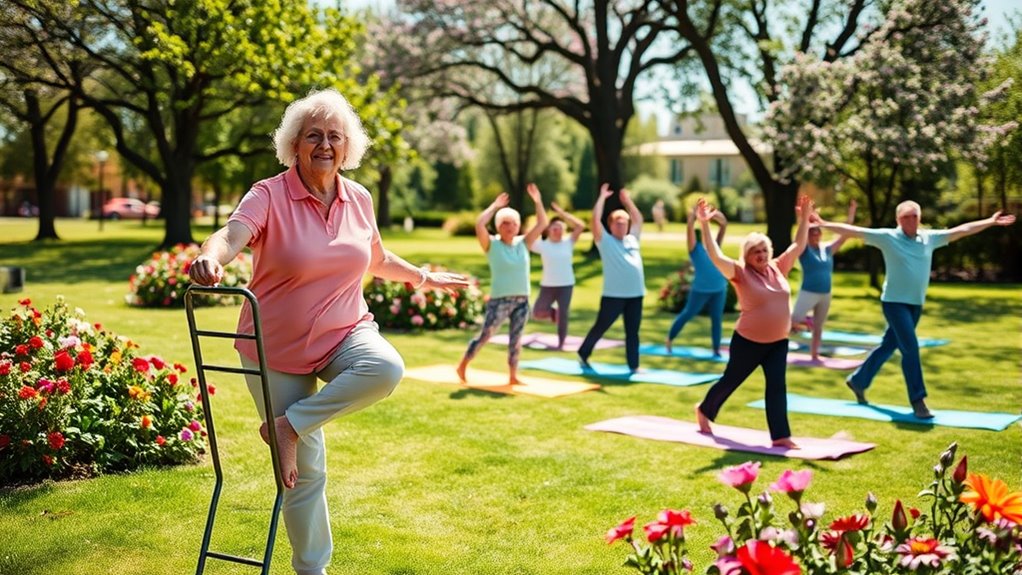
To create an effective exercise routine, you’ll want to focus on a few key components: aerobic activities, strength and flexibility exercises, and balance and coordination work. Aim for 150 minutes of moderate aerobic exercise each week, along with muscle-strengthening activities twice a week. Additionally, incorporating end-of-life care options can help ensure that seniors maintain their quality of life while staying active. It’s important to remember that open communication about feelings can also enhance emotional well-being, which supports overall health. Don’t forget to include balance and flexibility exercises to enhance your stability and range of motion. Moreover, establishing clear rules for children can promote a structured environment that encourages physical activity and independence for seniors. Additionally, incorporating home improvement strategies can help create a safe environment that encourages physical activity and independence for seniors. Providing adequate space in exercise areas can also help seniors move freely and safely during their routines.
Aerobic Activity Recommendations
Engaging in regular aerobic activity is essential for seniors looking to enhance their cardiovascular health and overall fitness. Older adults should aim for at least 150 minutes of moderate aerobic activity each week, such as walking, swimming, or cycling. These low-impact exercises effectively boost aerobic capacity without stressing your joints. You can break your sessions into manageable 10 to 15-minute increments, making it easier to fit exercise into your daily routine. Regular aerobic activity increases energy levels, improves sleep quality, and reduces symptoms of chronic diseases. Additionally, maintaining biodiversity in agriculture can support overall well-being by promoting access to healthy food options. Incorporating integrated pest management techniques in community gardens can also help ensure a sustainable supply of fresh produce. Furthermore, engaging in regular aerobic activity can foster a growth mindset, allowing seniors to embrace new challenges and improve their physical health. It’s also important to understand that hydration and nutrition play key roles in preventing fatigue and promoting recovery. Remember to gradually build your activity levels based on your abilities and health conditions. Always consult your healthcare provider if you’re unsure about starting a new exercise program. Furthermore, participating in outdoor activities like camping in national parks can provide additional physical and mental benefits while allowing seniors to enjoy nature.
| Activity | Duration (Minutes) | Frequency (Times/Week) |
|---|---|---|
| Walking | 30 | 5 |
| Swimming | 30 | 3 |
| Cycling | 30 | 3 |
Strength and Flexibility Exercises
While aerobic activities play an essential role in your fitness routine, incorporating strength and flexibility exercises is equally important.
Strength training for seniors, like wall push-ups and chair squats, should be done at least twice a week to enhance muscle strength and overall health. Engaging in visualization techniques can further motivate seniors to stick with their strength training routine. Additionally, using educational toys can encourage seniors to engage in playful physical activities that promote movement and coordination. Studies suggest that trust issues with boyfriends can impact motivation levels, which may be relevant to maintaining a consistent exercise schedule.
Flexibility exercises, such as daily neck and shoulder stretches, improve your range of motion and alleviate stiffness. Additionally, practicing relaxation techniques before these exercises can enhance their effectiveness and overall enjoyment.
Additionally, including balance exercises, like single-leg stands, three times a week can considerably reduce the risk of falls.
Engaging in a combination of strength and flexibility training boosts muscle mass and bone density, ensuring you maintain an active lifestyle.
Always adapt exercises to your capabilities, gradually increasing intensity for safety and effectiveness. Enhancing your routine with mindfulness through unplugging can also improve your overall mental well-being.
Balance and Coordination Focus
Incorporating balance and coordination exercises into your routine at least three times a week can greatly lower your risk of falls as you age. Engaging in activities like tai chi and yoga not only boosts your balance and coordination but also enhances your strength and flexibility, which are vital for overall stability. Cognitive decline can lead to increased fall risk, making balance training even more critical for seniors. Additionally, mastering the art of bug out bags can equip you with essential tools for safety and preparedness in various situations. It’s important to remember that proper installation of exercise equipment can also contribute to safety and effectiveness in your routine. Regular engagement in mindfulness practices can help you stay focused and present during these exercises, further enhancing your balance and coordination.
Simple exercises such as single-leg stands and weight shifting can be done daily, requiring minimal space and making them easy to access. By focusing on balance training, you improve your functional mobility, allowing you to perform daily tasks with greater ease and confidence. Evidence-based programs, like Tai Chi for Arthritis, have proven effective in enhancing strength, flexibility, and physical function, making them excellent choices for fall prevention. Additionally, participating in emotional health activities can further support your overall well-being and resilience as you age.
Strength Training Exercises for Seniors

Strength training exercises are vital for seniors, offering numerous benefits like enhanced muscle strength and improved balance.
By engaging in regular exercise, you can build muscle and reduce the risk of falls, ultimately improving your overall quality of life.
It’s recommended to incorporate strength training at least two days a week, focusing on major muscle groups with 12-15 repetitions per exercise.
Key bodyweight exercises include chair squats, bicep curls, and wall push-ups, which you can adapt using resistance bands or lighter weights.
Gradually introducing these exercises while emphasizing proper form is essential to prevent injury.
Consult your healthcare provider before starting any fitness program to guarantee you’re on the right track to enjoy the health benefits of strength training.
Balance Exercises to Prevent Falls
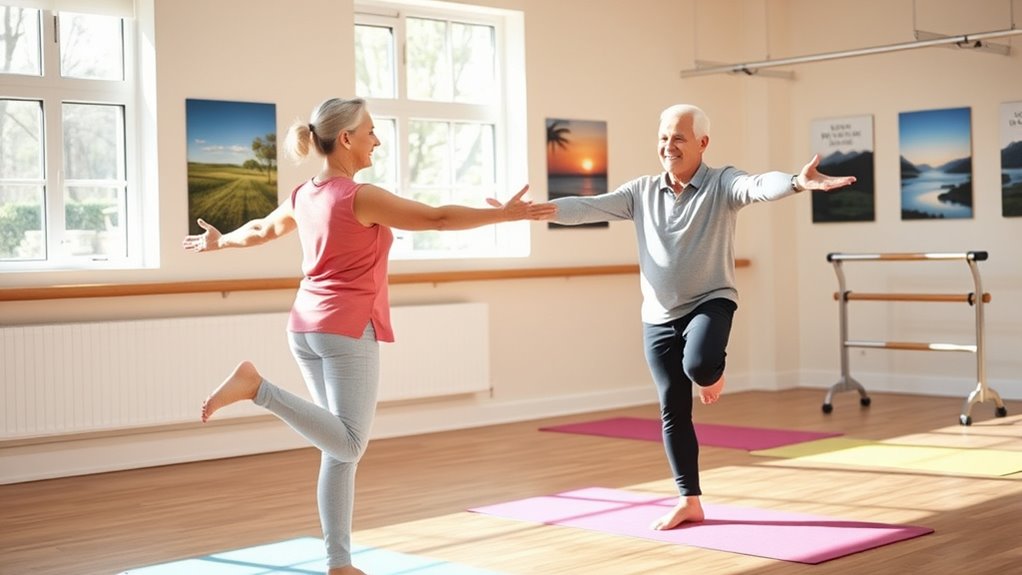
Building on the importance of strength training, balance exercises play an essential role in preventing falls among seniors. Engaging in these activities helps older adults enhance stability and coordination, ultimately improving mobility.
The CDC recommends incorporating balance exercises into your routine at least three times a week to effectively reduce the risk of falls.
Here are four accessible balance exercises you can try at home:
- Single-leg stands: Hold onto a sturdy surface and lift one leg off the ground.
- Weight shifting: Stand with feet shoulder-width apart and shift your weight from one foot to the other.
- Heel-to-toe walk: Walk in a straight line, placing the heel of one foot directly in front of the toes of the other.
- Tai chi: Practice slow, controlled movements to improve balance and functional fitness.
Flexibility Routines for Improved Mobility

Incorporating daily stretching routines can really boost your mobility and comfort as you age.
Simple exercises like neck stretches and ankle rotations can make a big difference in your range of motion.
Consistency is key, so aim for about 15 minutes each day to see lasting benefits.
Daily Stretching Benefits
As you age, maintaining flexibility becomes essential for preserving your mobility and independence. Daily stretching can help you achieve this by:
- Improving flexibility and range of motion, vital for everyday movements.
- Reducing muscle stiffness and joint pain, making activities more comfortable.
- Enhancing balance and coordination, which may lower your risk of falls.
- Promoting relaxation and mental well-being, contributing to an overall active lifestyle.
Incorporating simple stretches like neck stretches and shoulder rolls into your routine not only eases tension but also enhances circulation.
Simple Mobility Exercises
Simple mobility exercises are crucial for seniors looking to maintain their flexibility and ease of movement.
Incorporating gentle stretching routines into your daily life can greatly enhance mobility and improve your range of motion. Focus on simple movements, like neck stretches and shoulder rolls, holding each stretch for 15-30 seconds.
This practice not only helps maintain agility but also reduces the risk of injury, making it a critical part of your fitness program. A quick 15-minute routine of these exercises can promote well-being and improve movement efficiency.
By consistently practicing these mobility exercises, you’ll support better joint health and enjoy greater comfort in your everyday activities as you age.
Stay active and keep moving!
Low-Impact Cardiovascular Activities
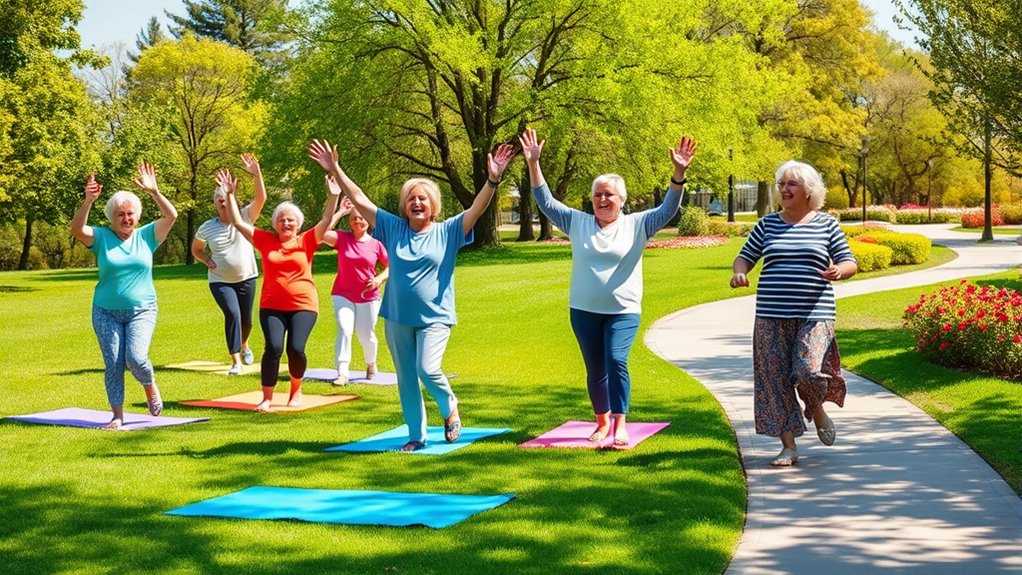
Low-impact cardiovascular activities are an excellent choice for seniors looking to boost their fitness without putting excessive strain on their bodies.
These activities help improve cardiovascular health while reducing the risk of injury. Here are four effective options for you to evaluate:
- Walking: A simple yet effective way to increase your fitness levels and maintain consistent movement.
- Water Aerobics: Provides resistance training and cardiovascular benefits in a joint-friendly environment.
- Tai Chi: Enhances balance and flexibility while promoting mental well-being through gentle movements.
- Group Classes: Engage with others, fostering motivation and making workouts enjoyable.
Incorporating these low-impact cardiovascular activities into your routine can greatly enhance your overall health and quality of life.
Recommended Weekly Exercise Schedule
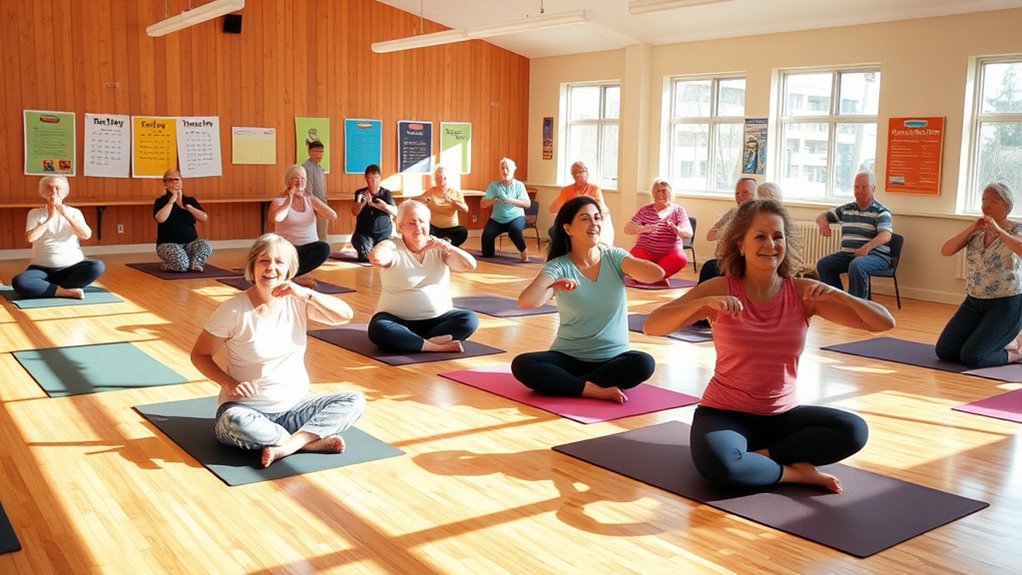
To maintain a healthy lifestyle, it’s essential to establish a well-structured weekly exercise schedule that fits your needs and abilities. Aim for at least 150 minutes of moderate aerobic activity each week.
Establish a tailored weekly exercise schedule to achieve at least 150 minutes of moderate aerobic activity for a healthy lifestyle.
A recommended weekly exercise schedule could start with walking for 15 minutes twice on Monday and Tuesday. On Wednesday, enjoy a 30-minute session of cycling, swimming, or Zumba.
Don’t forget muscle-strengthening activities on non-consecutive days, like wall push-ups or chair squats. Incorporate balance and flexibility exercises daily, such as tai chi or simple stretching routines.
Finally, allow for rest days, like Sunday, to promote recovery and maintain overall fitness levels. This balanced approach will keep you active and feeling great!
Tips for Staying Motivated and Consistent
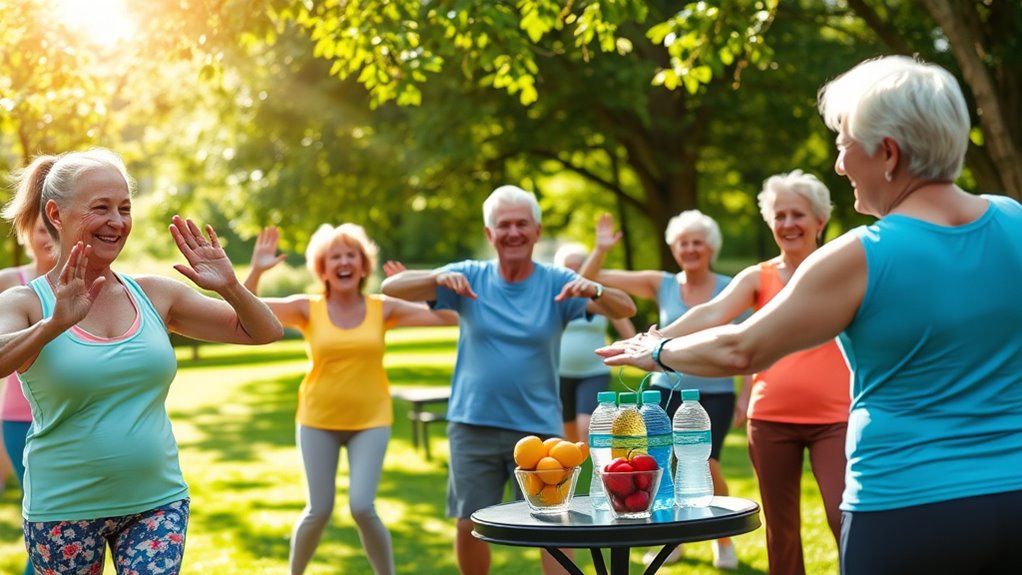
Staying motivated and consistent with your exercise routine can be challenging, especially as you age, but incorporating a few key strategies can make a significant difference.
Here are some tips to help you stay fit:
- Set realistic goals: Start small and gradually increase intensity to boost adherence to your exercise program.
- Establish a regular exercise schedule: Aim for at least 150 minutes of moderate-intensity physical activity each week.
- Join group exercise classes: Engaging in social settings can enhance motivation through camaraderie and support.
- Track your progress: Use a journal or fitness app to monitor achievements, reinforcing your commitment and highlighting improvements in strength and endurance.
Safety Considerations for Senior Exercisers
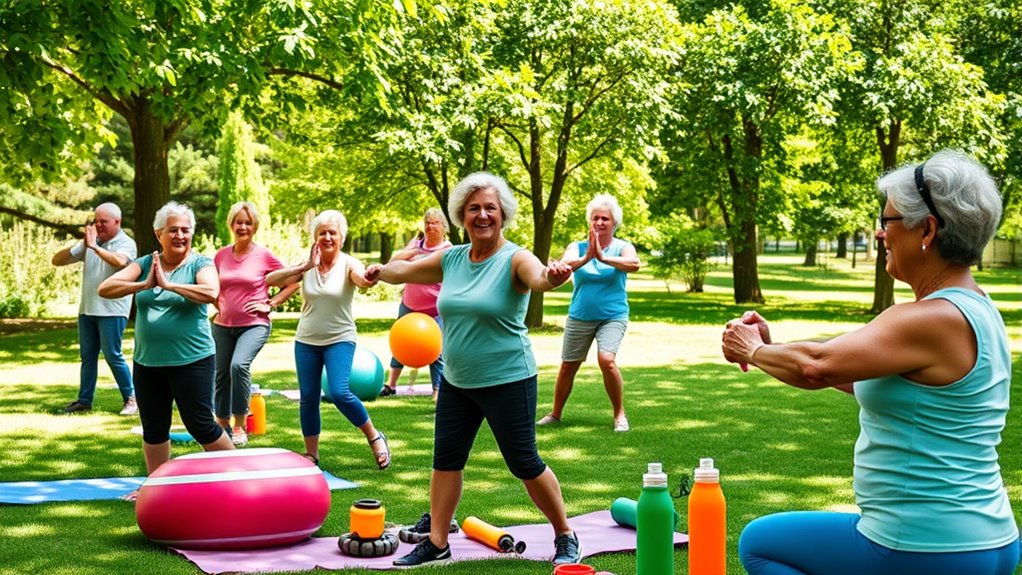
Before diving into a new exercise routine, it’s essential to contemplate safety, especially for seniors. Start by consulting your healthcare provider, especially if you have pre-existing health conditions.
Begin your exercise program slowly, listening to your body’s signals and adjusting intensity based on fatigue or dizziness. Using proper form is vital to prevent injuries, so consider seeking guidance from a trainer or instructional resources.
Don’t forget to utilize safety equipment, like supportive footwear or helmets when cycling, to reduce accident risks. Regularly assess your fitness levels and maintain open communication with your healthcare provider to track your progress and guarantee safe participation in your exercises.
Prioritizing safety will help you enjoy a fulfilling and injury-free fitness journey.
Frequently Asked Questions
What Is the Number One Exercise for Seniors?
The number one exercise for seniors is walking. It’s a low-impact activity that you can easily fit into your daily routine.
By aiming for 10,000 steps a day, you’re not just improving your cardiovascular health, but you’re also greatly lowering your risk of mortality.
Walking can be adjusted to suit your abilities and chronic conditions, making it accessible. Plus, joining a walking group can boost your motivation and help combat feelings of isolation.
What Is the Best Workout Program for Seniors?
Imagine your body as a garden, needing a variety of plants to flourish.
The best workout program for you includes 150 minutes of moderate aerobic activity each week, like walking or swimming, to keep your heart healthy.
Add two days of strength training to cultivate your muscles, and sprinkle in balance exercises like yoga to prevent falls.
Join a community class to enjoy the journey, nurturing both your body and spirit along the way.
What Is the Number 1 Exercise to Increase Balance in Seniors?
The number one exercise to boost your balance is the single-leg balance exercise.
You lift one foot off the ground and hold the position for 10 to 30 seconds before switching to the other leg. Doing this at least three times a week can greatly enhance your stability and reduce fall risks.
If you need support, you can use a chair or wall, making it accessible no matter your fitness level.
What Exercise Burns the Most Belly Fat for Seniors?
Think of belly fat as an unwelcome guest you need to evict!
For seniors, low-impact aerobic exercises like brisk walking or swimming are your best friends—they burn calories while being gentle on your joints.
Pair these with strength training at least twice a week to boost muscle mass and metabolism.
Don’t forget about the power of consistency; engaging in activities like cycling or water aerobics can really help you kick that belly fat to the curb!
Conclusion
Staying fit as a senior isn’t just a goal; it’s a journey. By embracing a tailored exercise program filled with strength training, balance work, and low-impact cardio, you’re not just moving—you’re thriving. Remember, every step you take brings you closer to better health and wellness. So, lace up those shoes, find your rhythm, and make each workout count. After all, it’s not about age; it’s about attitude, and your attitude is everything!

